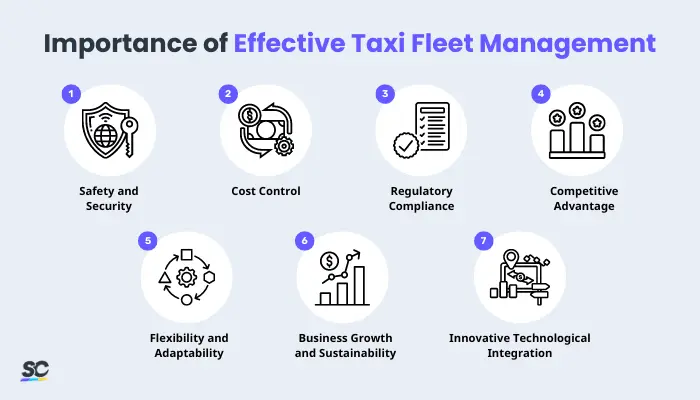What is Taxi Fleet Management?
Taxi fleet management is the comprehensive process of overseeing, coordinating, and optimizing the operations of a taxi fleet. It involves a set of tasks, activities, and strategies aimed at ensuring a taxi fleet’s efficient operation and optimizing resource utilization. This practice is crucial for both traditional taxi companies and modern ride-sharing platforms to provide reliable and timely transportation services to customers.
Fleet managers, logistics managers, operations managers, and even taxi drivers utilize a range of processes and tools to monitor fleet activities. Additionally, they use these to make informed decisions about asset management, dispatch and routing, vehicle acquisition and disposal, and compliance requirements.
Importance and Benefits of Effective Taxi Fleet Management
In the transportation industry, an effective fleet management system holds significant importance and offers a range of benefits for both taxi companies and their customers.

Importance of Effective Taxi Fleet Management
Here are a few key reasons why it’s crucial:
Safety and Security
Taxi fleet management ensures that vehicles are well-maintained and adhere to fleet safety standards, minimizing the risk of accidents. Also, background checks and training for drivers further enhance passenger safety and build trust in the service.
Cost Control
Effective management practices can lead to reduced fuel consumption, vehicle wear and tear, maintenance costs, and vehicle downtime. Over time, optimized routing and maintenance schedules contribute to significant cost savings.
Regulatory Compliance
Having a systematic taxi fleet management ensures that vehicles and drivers comply with local regulations and legal requirements. In turn, taxi companies can avoid fines and penalties while maintaining a professional reputation.
Competitive Advantage
Taxi companies that prioritize fleet management differentiate themselves in a competitive and rapidly evolving market. This is because a reliable and efficient service is more likely to attract more customers and retain existing ones.
Flexibility and Adaptability
An efficiently managed fleet can respond swiftly to changing demand patterns, special events, and peak hours. Two strategies that companies can consider in this aspect are dynamic dispatching and demand-responsive pricing, which enable taxi services to remain adaptable and relevant.
Business Growth and Sustainability
As a holistic approach, effective fleet management supports the growth and sustainability of taxi businesses. It enables companies to expand their reach, explore new opportunities, and adapt to evolving market trends.
Innovative Technological Integration
Embracing technology like mobile apps for booking, cashless payment options, and in-app customer support enhances the overall customer experience and keeps the business aligned with modern expectations.
Apart from those, taxi companies can also achieve the following benefits:
- Optimized Operations – enables taxi companies to deploy vehicles and drivers to meet customer demand
- Enhanced Customer Experience and Service – offers passengers a more reliable and timely service
- Data-Driven Decision-Making – allows companies to make informed decisions for operational efficiency, improvements, and better resource allocation
- Real-Time Tracking and Monitoring – enables companies to monitor their fleet’s location, status, and performance for better communication with drivers and passengers
Key Components
Taxi fleet management comprises essential components that collectively ensure the smooth operation and success of a taxi business. These encompass various aspects, including the following:
Fleet Size Determination
This component deals with the process of analyzing historical and real-time data to predict demand patterns. Also, taxi companies must assess peak hours, geographic areas, and special events to determine their ideal fleet size. They can do this by using data analytics and predictive modeling to make guided decisions.
Vehicle Selection and Maintenance
Since taxi companies have unique business models and approaches, they must select the most appropriate vehicle models on their fleet based on passenger preferences, comfort, and fuel efficiency. To help them ensure vehicle safety, performance, and longevity, regular maintenance schedules should be implemented. Further, vehicle health and mechanical issues must be monitored and addressed promptly to minimize downtime.
Driver Management
Highly qualified and licensed drivers with excellent driving records and customer service skills also play a big role. Hence, companies must provide comprehensive training to them encompassing various topics and aspects, including:
- vehicle operation;
- safety protocols; and
- customer interactions.
For a holistic approach, driver performance monitoring for compliance is also encouraged.
Technology Integration
To help streamline the overall process of managing a taxi fleet, integrating various kinds of tech like Global Positioning Systems (GPS) and navigation systems can be helpful. These enable real-time tracking, efficient routing, and better communication with drivers. Also, companies can utilize data analytics platforms to analyze customer behavior, review trends, and make transactions more convenient.
Dynamic Dispatching
Implementing dynamic dispatching algorithms to match passenger requests with available drivers in real time is another component of taxi fleet management. This can be done in conjunction with optimized route planning to reduce travel time and increase overall efficiency.
Demand-Responsive Pricing
Taxi companies can also introduce surge pricing during peak demand times to help balance supply and demand. On the other hand, offering discounts and incentives to encourage ridership during slower periods can also be effective.
Overall, this boils down to implementing transparent pricing models for enhanced customer trust and satisfaction.
Safety Measures
Ensuring driver and passenger safety is part of taxi companies’ responsibilities. This is why safety measures are one of the most important components of effective taxi fleet management. Some examples of how these can be implemented are the following:
- Conducting thorough background checks on drivers for passenger safety and security
- Implementing vehicle inspections and maintenance protocols to prevent accidents and breakdowns
Customer Experience Enhancement
Taxi fleet management goes beyond just ensuring the safety and quality of the taxi fleet. It must also pay attention to customer feedback and analyze it to create improvement actions. An example of how they can implement this is to provide options for shared rides to reduce costs and promote environmental sustainability.
Challenges in Taxi Fleet Management
Taxi fleet management faces a range of challenges that can impact operational efficiency, customer satisfaction, and overall business success. These challenges stem from factors such as technological advancements, market dynamics, and regulatory changes.
Recognizing and addressing these challenges is crucial for maintaining a competitive edge and delivering high-quality transportation services. Here are some common challenges taxi companies can encounter, which can be mitigated or addressed using proactive fleet management strategies:
- Competition from Ride-Sharing Services
- Regulatory Complexity
- Driver Recruitment and Retention
- Fluctuating Demand Patterns
- Operational Costs
- Technological Adaptation
- Data Security and Privacy
- Vehicle Maintenance and Downtime
- Changing Customer Expectations
- Sustainability and Environmental Concerns
- Urban Traffic Congestion
- Economic Volatility
Operational Efficiency Strategies for Managing Taxi Fleet
To help taxi companies effectively manage their fleet and ensure quality and safe operations, here are a few recommended steps they can take:
- Equip taxis with telematics devices and GPS tracking systems to monitor vehicle location, performance, and driver behavior.
- Optimize dispatch and routing to allocate taxis efficiently and plan the most optimal routes.
- Monitor driver performance to track their behavior, such as speeding, harsh braking, and idling, to improve driver performance, reduce accidents, and enhance fuel efficiency.
- Implement a proactive maintenance schedule to ensure that taxis are regularly serviced and in optimal condition.
- Use a centralized system or asset register to store and manage fleet data, including vehicle information, maintenance records, and driver profiles, and streamline data access.
- Use taxi fleet management software to ensure smooth operations, automate processes, and gain real-time visibility into fleet activities.
- Optimize fuel management strategies, such as monitoring fuel consumption, utilizing fuel cards, and promoting fuel-efficient driving practices, to reduce fuel costs.
- Regularly analyze fleet data, performance metrics, and customer feedback to implement a culture of continuous improvement and drive efficiency gains.
Digitize the way you Work
Empower your team with SafetyCulture to perform checks, train staff, report issues, and automate tasks with our digital platform.
Get Started for Free


